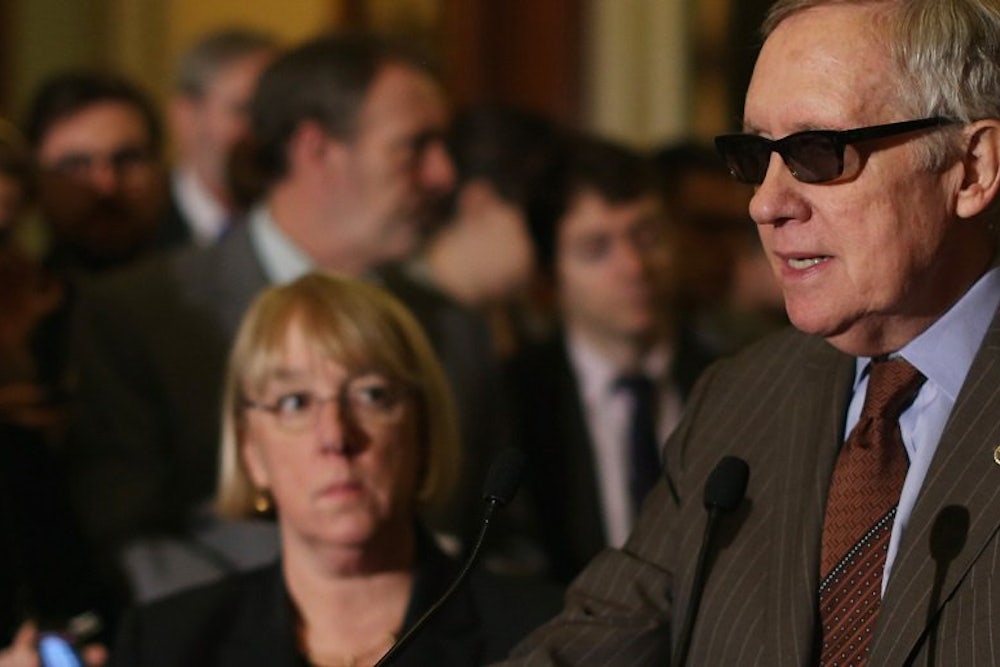Last week, in an extraordinarily rare moment of bipartisanship, House Republican and Democratic leaders reached an agreement on two big issues: An imment payment cut to Medicare providers and the looming expiration of a program for children's health insurance. The deal is a quintessential compromise: Democrats get some of what they want, Republicans get some of what they want and everyone ends up a little upset. But despite the agreement in the House, Senate Democrats are threatening to blow it up—a move that threatens to make Democrats the new “party of no.”
The problem House Speaker John Boehner and Minority Leader Nancy Pelosi are trying to solve began all the way back in 1997, when Congress passed a law to rein in Medicare payments using a new funding formula, the Sustainable Growth Rate (SGR). The goal was to hold down costs but it quickly began to require huge payments cuts to Medicare providers each year, cuts so large that doctors would exit the program. Since 2000, Congress has passed a so-called “doc fix” to prevent those cuts from happening, thus costing the federal government billions of dollars. This is obviously a myopic approach to controlling health care costs. But if Congress passed a permanent fix, it would cost a lot more money—much better to just address the issue on an annual basis, when the costs look smaller.1
This year, Congress decided to be proactive and find a long-term solution. Boehner and Pelosi reached an agreement to eliminate the huge cuts from the 1997 law in return for smaller cuts split between Medicare providers and beneficiaries. Vox’s Sarah Kliff has the full details, but here's the short of it: Hospitals would face some small cuts and the richest Medicare enrollees would have to pay higher premiums. Boehner and Pelosi also agreed to extend the Children’s Health Insurance Program (CHIP), which expires on September 30, for two years and provide $7.2 billion to community health centers. The total cost of the package is around $200 billion over 10 years.
As with any compromise, both sides have complaints. Many conservatives want the entire package to be offset with spending cuts. Boehner and a surprising ally, Grover Norquist’s Americans for Tax Reform (ATR), have responded that the Boehner-Pelosi deal doesn’t actually increase the deficit by much if you assume that Congress would pass a deficit-increasing doc fix each year. “There's just one problem with SGR,” ATR’s Ryan Ellis wrote, “it's a fake, phony spending cut.” Ellis is partially right. But as the Committee for a Responsible Federal Budget points out, the yearly doc fixes have been offset the vast majority of time, leading to billions of dollars in spending cuts. So while the law may not have accomplished what it set out to do, it hasn’t exactly been unsuccessful either.
For that reason, many deficit hawks in the House GOP have criticized the Boehner-Pelosi deal and want the speaker to renege on it. This is a key test for him. Now that he’s reached an agreement with Pelosi, is Boehner willing to defy the right wing of his conference and bring it up for a vote? Or will he fold under growing pressure?
Senate Democrats have their own concerns with the deal. They are upset with the premium increases on older Medicare beneficiaries and want CHIP extended for four years, not two. They also oppose a provision in the bill, known as a Hyde Amendment, that would prevent funding for community health providers from covering an abortion. Democrats should not let these relatively minor quibbles blow up the deal. Forcing rich Medicare beneficiaries to pay higher premiums is not a major cost to pay for eliminating the SGR. And the two-year CHIP extension, while not perfect, is still good. On the abortion provision, National Journal’s Sarah Mimms and Dylan Scott report why House Democrats, including the Pro-Choice Caucus, are supportive of the deal:
A House Democratic aide said Monday evening that Pelosi had worked with members of the House Pro-Choice Caucus to get additional language in the SGR package making clear that the Hyde language would expire after two years, when funding for the community health clinics runs out. After that, Congress could alter the language. But over these next two years, the aide said, the House will be controlled by Republicans. The language reflects the executive order Obama signed as part of the Affordable Care Act. ‘The status quo is the status quo,’ the aide said.
To be fair to Senate Democrats, there may be more politics at play here than they let on. By offering these objections, they demonstrate to the GOP that they are willing to walk away from any agreement, especially if conservatives in the Senate attempt to pull the deal to the right. That limits how far Republican senators can try to pressure Senate Majority Leader Mitch McConnell to tweak the House legislation. In other words, the Democratic objections may be less related to policy and more related to political positioning.
Still, Senate Democrats aren’t leaving themselves much room to maneuver. “I don’t like it,” said Senator Dianne Feinstein. “Unfortunately, our current understand of what the House is negotiating does not sufficiently pass the test.” Senator Sherrod Brown agreed. “The Democrats are going to stick together here,” he said. “I don’t see how you say yes to doctors and no to 10 million children.”
But that’s not really right. The deal says yes to doctors and yes to 10 million children—just for two years, not four.
If Senate Democrats ultimately block the agreement, Congress will reach some other doc fix deal. In that case, they’ll actually be saying yes to doctors and no to 10 million children—and Senate Democrats will be at fault.
Though that is difficult as well. Last year, Boehner snuck through the doc fix on a voice vote. It infuriated many members of his conference, something they still hold against him.
